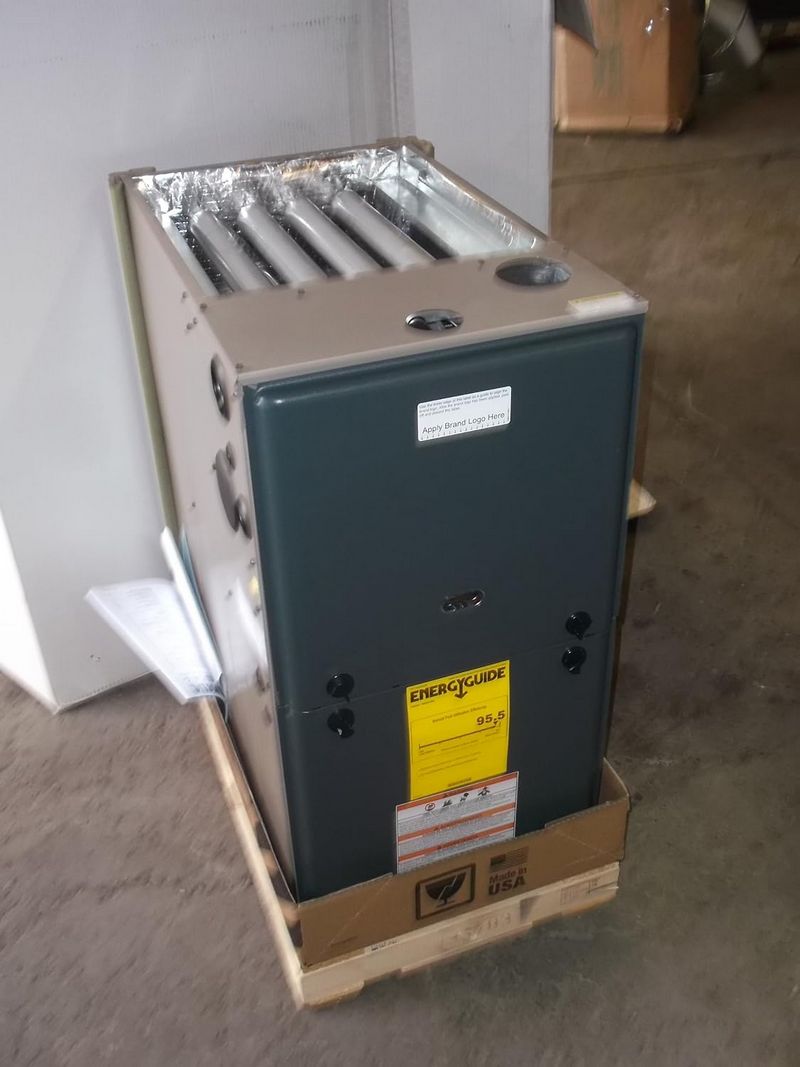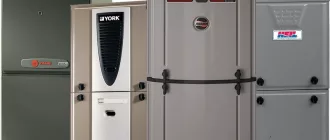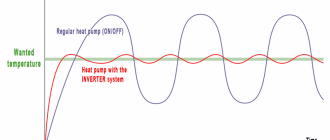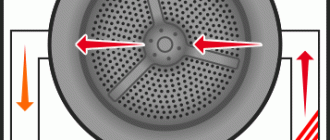
80% Efficiency vs. 95% Efficiency Furnaces.
When it comes to furnaces, choosing the right one for your home is crucial. One of the most important factors to consider is efficiency. Heating efficiency directly impacts both your comfort and your energy bills. In this article, we will discuss the differences between 80% efficiency and 95% efficiency furnaces to help you make an informed decision.
80% Efficiency Furnaces:
80% efficiency furnaces are a popular and cost-effective choice for many homeowners. These furnaces convert 80% of the fuel they consume into heat, while the remaining 20% is lost through combustion gases.
Although 80% efficiency may not seem the highest, these furnaces still provide reliable and consistent heating for your home. They are generally less expensive to purchase and install compared to higher efficiency models.
However, it’s important to note that 80% efficiency furnaces may result in higher energy bills in the long run. The wasted 20% of fuel can add up over time.
Interested in an 80% efficiency furnace? Contact us today to learn more!
95% Efficiency Furnaces:
95% efficiency furnaces are top-of-the-line when it comes to energy efficiency. These furnaces convert an impressive 95% of the fuel they consume into heat, with only 5% being lost through combustion gases. This means more heat is generated for your home and less energy is wasted.
While 95% efficiency furnaces may have a higher upfront cost, they can significantly reduce your energy bills in the long term. Their advanced technology ensures that your home stays warm while maximizing fuel efficiency.
Ready to experience the benefits of a 95% efficiency furnace? Contact us today to schedule an installation!
Choosing between 80% efficiency and 95% efficiency furnaces depends on your specific needs and budget. Consider factors such as upfront cost, long-term energy savings, and the size of your home. Our experienced team can help you make the best decision for your comfort and budget.
Factors to Consider
When choosing between 80% efficiency and 95% efficiency furnaces, there are several important factors to consider. Let’s take a closer look at each one:
| Energy Efficiency: | One of the main factors to consider is the energy efficiency of the furnace. An 80% efficiency furnace will convert 80% of the fuel it consumes into heat, while a 95% efficiency furnace will convert 95% of the fuel into heat. This means that a 95% efficiency furnace will provide greater energy savings and lower utility bills in the long run. |
| Cost: | Another factor to consider is the cost of the furnace. Generally, 95% efficiency furnaces tend to have a higher initial cost compared to 80% efficiency furnaces. However, it’s important to consider the long-term savings on utility bills. Over time, the energy savings of a 95% efficiency furnace may outweigh the higher upfront cost. |
| Environmental Impact: | Choosing a furnace with higher energy efficiency, such as a 95% efficiency furnace, can have a positive impact on the environment. These furnaces produce fewer greenhouse gas emissions, helping to reduce your carbon footprint and contribute to a cleaner, greener future. |
| Heating Performance: | Both 80% efficiency and 95% efficiency furnaces will effectively heat your home. However, a 95% efficiency furnace may provide more consistent and even heat distribution, resulting in increased comfort throughout your home. |
| Durability: | While both types of furnaces are built to last, 95% efficiency furnaces generally have more advanced features and technologies, which can contribute to their overall durability. Investing in a higher efficiency furnace may save you money on potential repairs or replacement parts in the long run. |
By considering these factors, you can make an informed decision on whether an 80% efficiency or 95% efficiency furnace is right for your home. Remember to consult with a heating professional who can provide personalized advice based on your specific needs and budget.
Energy Efficiency
When it comes to choosing a furnace for your home, energy efficiency is an important factor to consider. The efficiency of a furnace is measured in terms of how much of the energy it consumes is actually converted into heat.
In this regard, the comparison between 80% efficiency furnaces and 95% efficiency furnaces is crucial. An 80% efficiency furnace means that 80% of the energy it consumes is converted into heat, while a 95% efficiency furnace converts 95% of the energy into heat.
Although the initial cost of a 95% efficiency furnace may be higher compared to an 80% efficiency furnace, the higher efficiency can result in significant energy savings over time. This is especially true when you consider the fact that heating and cooling account for a large portion of household energy consumption.
By choosing a furnace with higher efficiency, you can reduce your energy bills and also contribute to environmental conservation by reducing your carbon footprint. Additionally, an energy-efficient furnace can provide better comfort and temperature control in your home, as it is able to distribute heat more evenly and maintain a consistent temperature.
When making your decision, it is important to consider your specific heating needs and budget. An 80% efficiency furnace may be a suitable option if you are on a tighter budget or if you live in a region with milder winters. However, if you prioritize long-term energy savings and environmental impact, a 95% efficiency furnace may be the right choice for you.
In conclusion, energy efficiency is a key factor to consider when choosing a furnace. Whether you opt for an 80% efficiency furnace or a 95% efficiency furnace, it is important to weigh the initial cost, long-term energy savings, and environmental impact to make an informed decision that best suits your needs.
Cost
When it comes to cost, there is typically a difference between furnaces with 80% efficiency and those with 95% efficiency. The initial cost of a furnace with 80% efficiency is usually lower compared to a furnace with 95% efficiency.
However, it’s important to consider the long-term savings that come with a more efficient furnace. A furnace with 95% efficiency can help lower your energy bills over time, as it wastes less heat and uses fuel more effectively.
Additionally, a furnace with higher efficiency may qualify for government incentives or rebates, further reducing its cost. These incentives can vary depending on your location, so it’s worth checking with your local energy provider or government agency.
In terms of maintenance and repairs, furnaces with higher efficiency may have more complex components, leading to potentially higher repair costs. However, these furnaces typically come with warranties that can help offset these expenses.
Ultimately, the choice between a furnace with 80% efficiency and one with 95% efficiency depends on your budget and long-term goals. If you’re looking for immediate savings and lower upfront costs, a furnace with 80% efficiency may be the right choice. However, if you’re focused on long-term energy savings and are willing to invest more upfront, a furnace with 95% efficiency will likely be a better option.
Environmental Impact
When it comes to the environmental impact, the efficiency of furnaces plays a crucial role. The difference between 80% and 95% efficiency is not only significant in terms of energy savings, but also in reducing greenhouse gas emissions.
An 80% efficiency furnace, although relatively efficient, still wastes 20% of the energy it consumes. This wasted energy translates into higher energy bills for homeowners and increased carbon dioxide emissions. With an 80% efficiency furnace, you are contributing more to climate change and wasting valuable natural resources.
On the other hand, a 95% efficiency furnace operates at a much higher level of efficiency. This means that only 5% of the energy it consumes is wasted. By choosing a 95% efficiency furnace, you can significantly reduce your carbon footprint and save money on your energy bills.
| Energy Waste | 20% | 5% |
| Greenhouse Gas Emissions | High | Low |
Choosing a furnace with a higher efficiency rating, such as a 95% efficiency furnace, not only helps you save money in the long run, but also contributes to a more sustainable future. By reducing energy waste and greenhouse gas emissions, you are making a positive impact on the environment and doing your part in the fight against climate change.
Maintenance
Maintaining a furnace is an important part of ensuring its longevity and efficiency, regardless of its level of efficiency. Both 80% and 95% efficiency furnaces require regular maintenance to operate at their best.
For 80% efficiency furnaces, regular maintenance is crucial to ensure optimal performance. This includes cleaning or replacing the furnace filter regularly, inspecting the burner and ignition system, and checking for any signs of wear or damage. It is also important to schedule annual professional inspections and tune-ups to keep the furnace running smoothly.
Similarly, 95% efficiency furnaces also require regular maintenance to maintain their high level of efficiency. In addition to cleaning or replacing the furnace filter and inspecting the burner and ignition system, it is recommended to regularly check all system components for proper functioning. Professional inspections and tune-ups should still be scheduled annually to identify and address any potential issues.
By regularly maintaining both 80% and 95% efficiency furnaces, homeowners can ensure that their heating system operates efficiently and effectively, saving them energy and money in the long run.
80% Efficiency Furnaces
When it comes to furnaces, one of the main factors to consider is their efficiency. An 80% efficiency furnace means that 80% of the energy it consumes is converted into heat, while the remaining 20% is lost. While not as efficient as their 95% efficiency counterparts, 80% efficiency furnaces are still a popular choice for many homeowners.
Advantages of 80% Efficiency Furnaces:
- Cost: One of the main advantages of 80% efficiency furnaces is their lower cost compared to 95% efficiency furnaces. This makes them a more practical option for homeowners who are on a tighter budget.
- Availability: 80% efficiency furnaces are widely available and can be easily found on the market. They are a common choice for many homeowners.
- Reliability: 80% efficiency furnaces have been around for a long time and have proven to be reliable heating sources for homes. They are a tried and tested option.
While 80% efficiency furnaces may not be as energy-efficient as their 95% efficiency counterparts, they still provide a significant level of heat and can effectively warm your home during the colder months.
It’s important to consider your specific heating needs and budget when deciding between an 80% efficiency furnace and a 95% efficiency furnace. Consulting with a heating professional can help you make an informed decision and choose the right furnace for your home.
Benefits of 80% Efficiency Furnaces
When choosing a furnace for your home, it’s important to consider the level of efficiency that best suits your needs. While a 95% efficiency furnace may seem like the obvious choice, there are several benefits to opting for an 80% efficiency furnace.
- Cost-effective: One of the primary benefits of an 80% efficiency furnace is its affordability. These furnaces typically come at a lower price point compared to their higher efficiency counterparts, making them a great option for homeowners on a budget.
- Ease of installation: Installing an 80% efficiency furnace is generally less complex and time-consuming compared to higher efficiency models. This can save you both time and money on installation costs.
- Less maintenance: With the simplicity of an 80% efficiency furnace comes less maintenance. These furnaces often have fewer components and technology, resulting in fewer parts that can break down or require regular maintenance.
- Compatibility: If you already have an existing heating system, choosing an 80% efficiency furnace can be a better option for compatibility. These furnaces can integrate seamlessly with older ductwork and systems, saving you the hassle and additional costs of retrofitting.
- Proven technology: While 95% efficiency furnaces may have the latest technology, 80% efficiency furnaces have been around for a long time and have proven to be reliable and effective. They have a track record of providing consistent warmth and comfort to homes.
While a 95% efficiency furnace may offer better energy savings, there are clear advantages to choosing an 80% efficiency furnace. Consider your specific needs, budget, and existing system when making your decision. Ultimately, both options can provide efficient and reliable heating for your home.
Drawbacks of 80% Efficiency Furnaces
While 80% efficiency furnaces may be a popular choice for some homeowners, they do have a few drawbacks to consider:
- Lower energy efficiency: Compared to 95% efficiency furnaces, 80% efficiency furnaces are less energy efficient. This means that they waste more energy, leading to higher utility bills over time.
- Increased environmental impact: With lower efficiency comes increased carbon emissions. 80% efficiency furnaces produce more greenhouse gases and contribute to air pollution more than their higher efficiency counterparts.
- Less consistent heating: The heat output of 80% efficiency furnaces may not be as consistent as 95% efficiency furnaces. This can result in uneven room temperatures and less comfortable living spaces.
- Shorter lifespan: In general, 80% efficiency furnaces have a shorter lifespan compared to 95% efficiency furnaces. This means that you may need to replace your furnace sooner, leading to additional costs in the long run.
- Limited warranty: Some manufacturers may offer a shorter warranty for 80% efficiency furnaces compared to the warranty provided for higher efficiency models. This means that you may have less protection and coverage for potential repairs or replacements.
It is important to weigh these drawbacks against the potential cost savings of choosing an 80% efficiency furnace. Consider your specific needs and budget before making a decision.
95% Efficiency Furnaces
When it comes to choosing a furnace, efficiency plays a crucial role. A 95% efficiency furnace is a top-of-the-line option that offers exceptional performance.
With a 95% efficiency furnace, you can expect to save significantly on your energy bills compared to an 80% efficiency furnace. This means that more of the energy used to heat your home is actually converted into usable heat, reducing waste and maximizing cost savings.
One of the key benefits of a 95% efficiency furnace is its ability to provide consistent and even heat throughout your home. The advanced technology and design of these furnaces ensure that every room stays comfortable and warm, no matter the outside temperature.
Additionally, a 95% efficiency furnace is also environmentally friendly. By reducing energy waste, you’ll be doing your part to decrease your carbon footprint and help protect the planet.
Furthermore, these furnaces are built to last. With high-quality components and materials, a 95% efficiency furnace offers durability and reliability, ensuring many years of trouble-free operation.
In summary, if you value energy efficiency, consistent heat, and sustainability, a 95% efficiency furnace is the right choice for you. It will not only save you money in the long run but also provide you and your family with unparalleled comfort and peace of mind.
Benefits of 95% Efficiency Furnaces
When it comes to comparing furnaces, the efficiency rating is an important factor to consider. A 95% efficiency furnace offers several benefits over an 80% efficiency furnace.
| Energy Savings | With a 95% efficiency furnace, you can save significantly on your energy bills. These furnaces convert 95% of the fuel into usable heat, wasting only 5%. This leads to lower energy consumption and reduced expenses. | An 80% efficiency furnace, on the other hand, converts only 80% of the fuel into usable heat, wasting 20%. |
| Environmental Impact | By using a 95% efficiency furnace, you can reduce your carbon footprint. These furnaces produce fewer greenhouse gas emissions, helping to protect the environment and combat climate change. | An 80% efficiency furnace emits a greater amount of greenhouse gases compared to a 95% efficiency furnace. |
| Comfort | A 95% efficiency furnace can provide consistent and reliable heat, keeping your home comfortable even in extreme weather conditions. The higher efficiency means that the furnace can maintain a steady temperature without constantly cycling on and off. | An 80% efficiency furnace may struggle to maintain a consistent temperature, resulting in fluctuations and less comfort. |
| Long-Term Investment | Although a 95% efficiency furnace may have a higher upfront cost compared to an 80% efficiency furnace, it can be a wise long-term investment. The energy savings and lower operating costs make up for the initial expense, leading to significant savings over the lifespan of the furnace. | An 80% efficiency furnace may seem more affordable initially, but it can result in higher energy bills and maintenance costs over time. |
In summary, a 95% efficiency furnace offers energy savings, environmental benefits, improved comfort, and long-term cost savings. If you are looking for a heating solution that maximizes efficiency and minimizes energy waste, a 95% efficiency furnace is the right choice for you.
Drawbacks of 95% Efficiency Furnaces
While 95% efficiency furnaces offer numerous benefits, there are a few drawbacks to consider before making a decision.
1. Cost: 95% efficiency furnaces are generally more expensive upfront compared to 80% efficiency furnaces. The higher price is due to the advanced technology and materials used in their construction.
2. Higher Electric Bills: 95% efficiency furnaces use electricity to power their fans and other components. This can result in higher monthly electric bills compared to 80% efficiency furnaces, which rely solely on gas.
3. Increased Maintenance: While 95% efficiency furnaces are designed to be efficient, they can require more maintenance compared to their 80% efficiency counterparts. The complex components and advanced technology may necessitate more frequent inspections and cleaning.
4. Limited Venting Options: The high efficiency of 95% furnaces requires specific venting systems to safely expel combustion byproducts. This can limit the installation options available in your home and potentially increase installation costs.
5. Greater Sensitivity to Installation: 95% efficiency furnaces are more sensitive to proper installation than 80% efficiency furnaces. Improper installation can lead to decreased efficiency, increased energy consumption, and even potential safety hazards.
While 95% efficiency furnaces have their drawbacks, it’s important to weigh them against the numerous benefits they offer. Consider your budget, energy consumption, and specific heating requirements before making a decision.
Choosing the Right Efficiency
When it comes to choosing a furnace for your home, one of the most important factors to consider is efficiency. The efficiency of a furnace refers to how effectively it converts fuel into heat. In this comparison, we will take a closer look at the differences between a furnace with 80% efficiency and one with 95% efficiency.
vs.
A furnace with 80% efficiency is a good option for those looking for a budget-friendly choice. While it may not be as efficient as a 95% efficiency furnace, it still provides reliable heating for your home. With an 80% efficiency furnace, you can expect to have lower upfront costs and potentially lower operating costs compared to higher efficiency models.
On the other hand, a furnace with 95% efficiency offers greater energy savings and a higher level of performance. This means that it can convert a higher percentage of fuel into heat, resulting in lower energy consumption and potentially lower utility bills. However, the initial cost of purchasing a 95% efficiency furnace may be higher compared to an 80% efficiency model.
Ultimately, the right efficiency for you depends on your budget, energy savings goals, and the specific heating needs of your home. It’s important to consider factors such as the climate you live in, your home’s insulation, and your personal preferences when making a decision. Consulting with a heating professional can also help you determine the most suitable efficiency for your needs.
In conclusion, both 80% efficiency and 95% efficiency furnaces have their advantages and considerations. By carefully evaluating your budget and heating requirements, you can make an informed decision and choose the furnace that is right for you.
Heating Needs
When it comes to choosing between 80% and 95% efficiency furnaces, it’s important to consider your heating needs. Different homes have different heating requirements, so it’s essential to understand what will work best for you.
An 80% efficiency furnace is a budget-friendly option that provides adequate heating for most homes. It is less expensive upfront but may result in higher energy bills in the long run. These furnaces are suitable for moderate climates and smaller homes where heating needs may not be as high.
On the other hand, a 95% efficiency furnace offers higher energy savings and better performance. It is more expensive upfront but can significantly reduce your energy bills over time. These furnaces are ideal for colder climates and larger homes where heating needs are greater.
Ultimately, the choice between 80% and 95% efficiency furnaces depends on your specific heating needs, budget, and long-term energy savings goals. It’s recommended to consult with a professional HVAC technician who can assess your home’s requirements and provide personalized advice.
By considering your heating needs and understanding the differences between these furnaces, you can make an informed decision and choose the right option for your home.
Budget
When it comes to choosing between a 80% efficiency and a 95% efficiency furnace, the budget is an important factor to consider. While a 95% efficiency furnace may offer better energy savings in the long run, it also comes with a higher upfront cost.
For those on a tight budget, an 80% efficiency furnace might be a more affordable option. While it may not provide the same level of energy savings as a 95% efficiency furnace, it can still offer significant improvements over older, less efficient models.
Additionally, choosing an 80% efficiency furnace can free up some budget for other home improvement projects or necessary repairs. It’s important to evaluate your financial situation and determine what percentage of your budget you are comfortable allocating towards a new furnace.
Ultimately, the decision between an 80% efficiency and a 95% efficiency furnace will depend on your specific financial circumstances and energy efficiency goals. Consulting with a professional HVAC technician can help you navigate the options and make an informed decision.
Long-Term Goals
When considering which furnace to choose for your home, it’s important to think about your long-term goals. The efficiency of your furnace plays a significant role in your overall energy consumption and can have a lasting impact on your utility bills. Here, we compare the benefits of 80% efficiency versus 95% efficiency furnaces to help you make an informed decision.
- Energy Savings: A 95% efficiency furnace can provide significant energy savings compared to an 80% efficiency furnace. Over time, this can result in lower monthly utility bills and help you save money in the long run.
- Environmental Impact: Higher efficiency furnaces produce fewer greenhouse gas emissions, reducing your carbon footprint and contributing to a more sustainable future. Choosing a 95% efficiency furnace aligns with eco-friendly practices and can help protect the environment.
- Comfort: A 95% efficiency furnace is designed to provide more consistent and even heating throughout your home. This can help eliminate cold spots and improve overall comfort, ensuring a cozy living environment for you and your family.
- Durability: Higher efficiency furnaces are often built with advanced technology and superior materials, increasing their lifespan and reducing the need for frequent repairs or replacements. Investing in a 95% efficiency furnace can offer long-term durability and reliability.
- Resale Value: Upgrading to a 95% efficiency furnace can enhance the value of your home in the long run. Energy-efficient features are highly sought after by potential buyers, making your property more attractive in a competitive real estate market.
Ultimately, the choice between an 80% efficiency and 95% efficiency furnace depends on your specific needs and budget. By considering your long-term goals, you can make an informed decision and select the furnace that best meets your requirements.
Q&A:
What is the difference between an 80% efficiency furnace and a 95% efficiency furnace?
The main difference between an 80% efficiency furnace and a 95% efficiency furnace is their fuel utilization efficiency. An 80% efficiency furnace converts 80% of the fuel it uses into heat, while a 95% efficiency furnace converts 95% of the fuel it uses into heat. This means that a 95% efficiency furnace is more energy efficient and will result in lower heating costs.
How much money can I save with a 95% efficiency furnace compared to an 80% efficiency furnace?
The exact amount of money you can save with a 95% efficiency furnace compared to an 80% efficiency furnace will depend on various factors such as the size of your home, the climate you live in, and your heating usage. However, on average, you can expect savings of up to 20% on your heating costs with a 95% efficiency furnace.
Are there any drawbacks to using a 95% efficiency furnace?
While a 95% efficiency furnace offers many benefits, there are a few potential drawbacks to consider. One drawback is the higher upfront cost of a 95% efficiency furnace compared to an 80% efficiency furnace. Additionally, a 95% efficiency furnace may require more frequent maintenance and have more complex installation requirements.
Will a 95% efficiency furnace make my home warmer than an 80% efficiency furnace?
A 95% efficiency furnace will not necessarily make your home warmer than an 80% efficiency furnace. The efficiency rating measures how much of the fuel is converted into heat, not the actual heat output. However, a 95% efficiency furnace may be better at distributing heat evenly throughout your home, resulting in a more consistent and comfortable temperature.
Is it worth it to invest in a 95% efficiency furnace?
Whether it is worth it to invest in a 95% efficiency furnace depends on your individual circumstances. If you live in a cold climate and have high heating costs, the energy savings from a 95% efficiency furnace can add up over time and make it a worthwhile investment. However, if you live in a milder climate or have relatively low heating costs, the difference in energy savings may not be as significant.
What is the difference between an 80% efficiency furnace and a 95% efficiency furnace?
The main difference between an 80% efficiency furnace and a 95% efficiency furnace is the amount of energy they use. An 80% efficiency furnace converts 80% of the fuel it uses into heat, while a 95% efficiency furnace converts 95% of the fuel into heat. This means that a 95% efficiency furnace is more efficient and will use less fuel to generate the same amount of heat as an 80% efficiency furnace.






